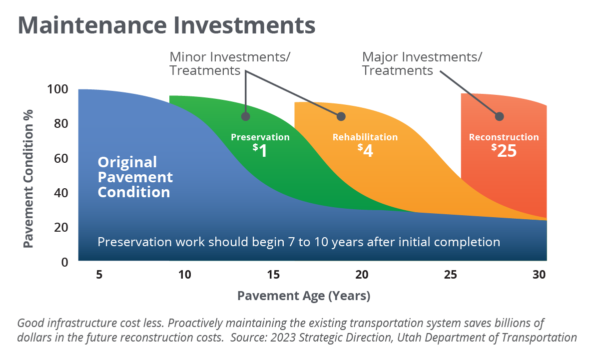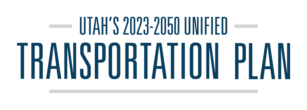Funding the Plan
An important aspect of Utah’s Unified Transportation Plan is analyzing and ultimately determining how transportation projects in Utah should be funded. This includes projecting what funding sources will be used for which projects and in what order. Utah’s transportation planners and policymakers take great care in funding the Unified Plan in a fiscally responsible and efficient way.
Prudent Funding and Project Phasing
Utah’s transportation agencies work together to develop assumed funding projections for the duration of the Unified Plan. The goal is to then create a financially constrained Plan that’s fiscally prudent and meets transportation needs. Because resources are limited, not all transportation needs can be met.
The process begins with an Unconstrained Needs-Based Project List. Projects are then prioritized based on critical needs, agency goals, and new and existing revenue assumptions. This leads to the Fiscally Constrained Project List. Ultimately, projects are planned to be constructed in three phases: Phase 1 (2023-2032), Phase 2 (2033-2042), and Phase 3 (2043-2050). Each project is modeled when it is needed, but because of limited resources projects may be moved to a later phase, or even moved beyond the planning time horizon and considered “unfunded.”
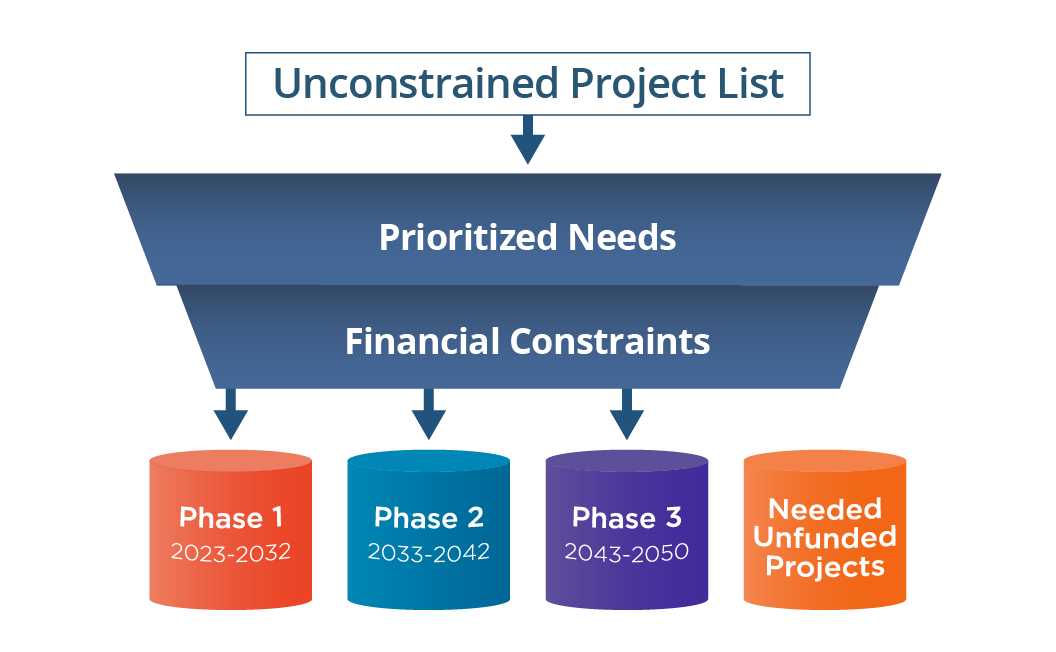
Needs and Prioritization
Utah’s 2023-2050 Unified Transportation Plan estimates a total transportation funding need of $153 billion in today’s dollars. This includes funding to operate Utah’s current transportation system and to preserve and maintain the infrastructure in good condition. It also includes the funding needed to increase capacity, meet growing travel demands, and provide more transportation options by: 1) building new state and local roads, 2) widening and making operational enhancements to existing roads, 3) building new transit lines, 4) upgrading existing transit lines, 5) providing more frequent trail and bus service, 6) constructing new biking and walking trails, and 7) improving existing biking and walking trails.
For planning purposes, Utah’s Unified Transportation Plan assumes that all the existing revenue sources (revenue sources that are currently in place today, or their equivalents) will generate $94.4 billion (in today’s dollars) between 2023 and 2050. So, of the $153 billion of transportation funding needs that have been identified, current revenue sources will cover $94.4 billion. The Plan then assumes that an additional $18.4 billion in revenue will be generated from new sources that will be adopted or established, allowing for a total fiscally constrained Plan of $113B. This would still leave $39.8 billion as the remaining amount needed in order to fund all of Utah’s transportation needs.

It is important to note that the Unified Plan makes planning-level assumptions and projections about the availability of revenues. The actual availability of that revenue depends on the performance of those revenue sources, as well as the authorization of additional revenue sources that have been assumed. Furthermore, future action will be needed to allocate available funding to specific projects (referred to as the “programming” of projects). A project being included in the fiscally constrained Unified Plan project list doesn’t guarantee it will ultimately be programmed for funding.
Revenue Sources
The Unified Transportation Plan Financial Model assumes that current revenue sources for transportation will remain in place or be replaced by equivalent sources. For example, the Unified Plan assumes that the revenues coming from transportation user fees such as the current motor fuel tax — or a replacement such as a road usage charge — will continue and grow gradually over time. The Unified Plan makes projections about the growth of those revenue sources, based on historical trends and economic analysis. The Unified Plan also makes projections about revenues that would be generated from new sources or increases to existing sources, such as additional local option transportation sales taxes. These projections are based on reasonable and prudent assumptions reflecting historical trends, economic assumptions, and policy implementation. Importantly, the Unified Plan does not assume that revenues will be available to meet all transportation needs.

For planning purposes, Utah’s Unified Transportation Plan assumes that existing revenue, from the following sources or options, will generate $94.4B (in today’s dollars between 2023 and 2050):
- State motor fuel and diesel taxes (or equivalent replacement sources)
- Vehicle registration fees
- Local option transportation sales taxes
- Federal funding
- State auto-related sales taxes
- One-time legislative appropriations (for base year)
- Local general funds
For planning purposes, Utah’s Unified Transportation Plan assumes that new revenue, from the following sources or options, will generate $18.4B (in today’s dollars between 2023 and 2050):
- Statewide motor fuel and diesel tax increases (or equivalent replacement sources)
- Statewide vehicle registration fee increase
- Local community vehicle registration fee increase
- Local community sales tax increase
- Limited financing or bonding
- Federal grant funding for eligible transit projects
- Private-sector funding to build local roads
The specific funding mechanisms will depend on decisions by federal, state, and local policymakers. The Unified Plan — in an attempt to be prudently and fiscally conservative in its assumptions — does not assume significant private contributions to transportation (other than developer-paid impact fees), nor does it assume the use of value-capture techniques, such as Transportation Reinvestment Zones or tax increment financing. However, these are potential additional sources, among others, to potentially generate revenue for infrastructure investment. It’s important to note that the majority of revenue assumed in the plan is for planning purposes. Future action to program projects from the plan, with actual funding, still needs to occur. A project being listed on the fiscally constrained list doesn’t guarantee it will be selected for funding.
Most funding sources that are available for transportation are prescribed by federal or state law or constitution to be used for a particular category of investment, such as state roads, local roads, or transit. The Unified Plan identifies needs and revenue estimates in each of these categories, and revenues are estimated and/or assumed to be available in these categories. The actual availability of funding will depend on a variety of factors, including tax policy and evolving economic conditions.
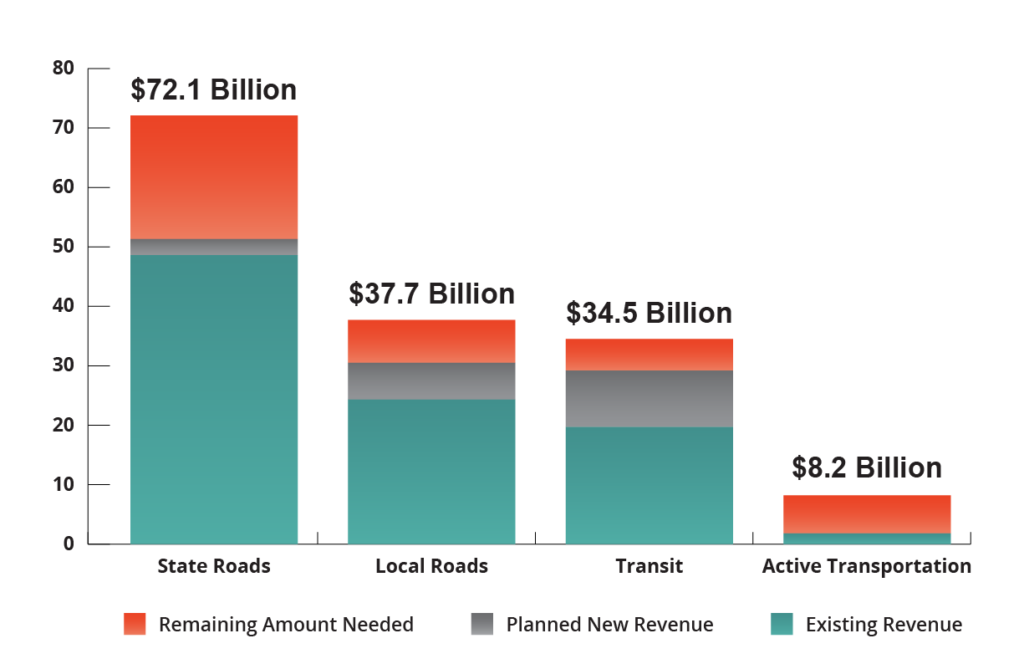
Funding Today's Transportation
Utah benefits from a significant mix of funding from federal, state, and local sources. Passage of the federal Infrastructure Investment and Jobs Act (IIJA) provides steady formula funding sources and an array of new discretionary grant programs. In addition, the Utah State Legislature continues to invest in transportation statewide and has expanded allocations for transit and a new dedicated funding source for the statewide Utah Trail Network. Local governments use sales tax and general funds for their transportation systems. This financial support allows state and local leaders to move forward with high-priority projects that will help maintain and improve quality of life for all Utahns.
Below is an example of how these funding sources are allocated for state roads, local roads, transit systems, and active transportation. This is a snapshot of the breakdown of the $3.2 billion in statewide funding sources for the maintenance, operation, and construction of Utah’s transportation systems in 2024 (not including potential one-time funding additions or grants).
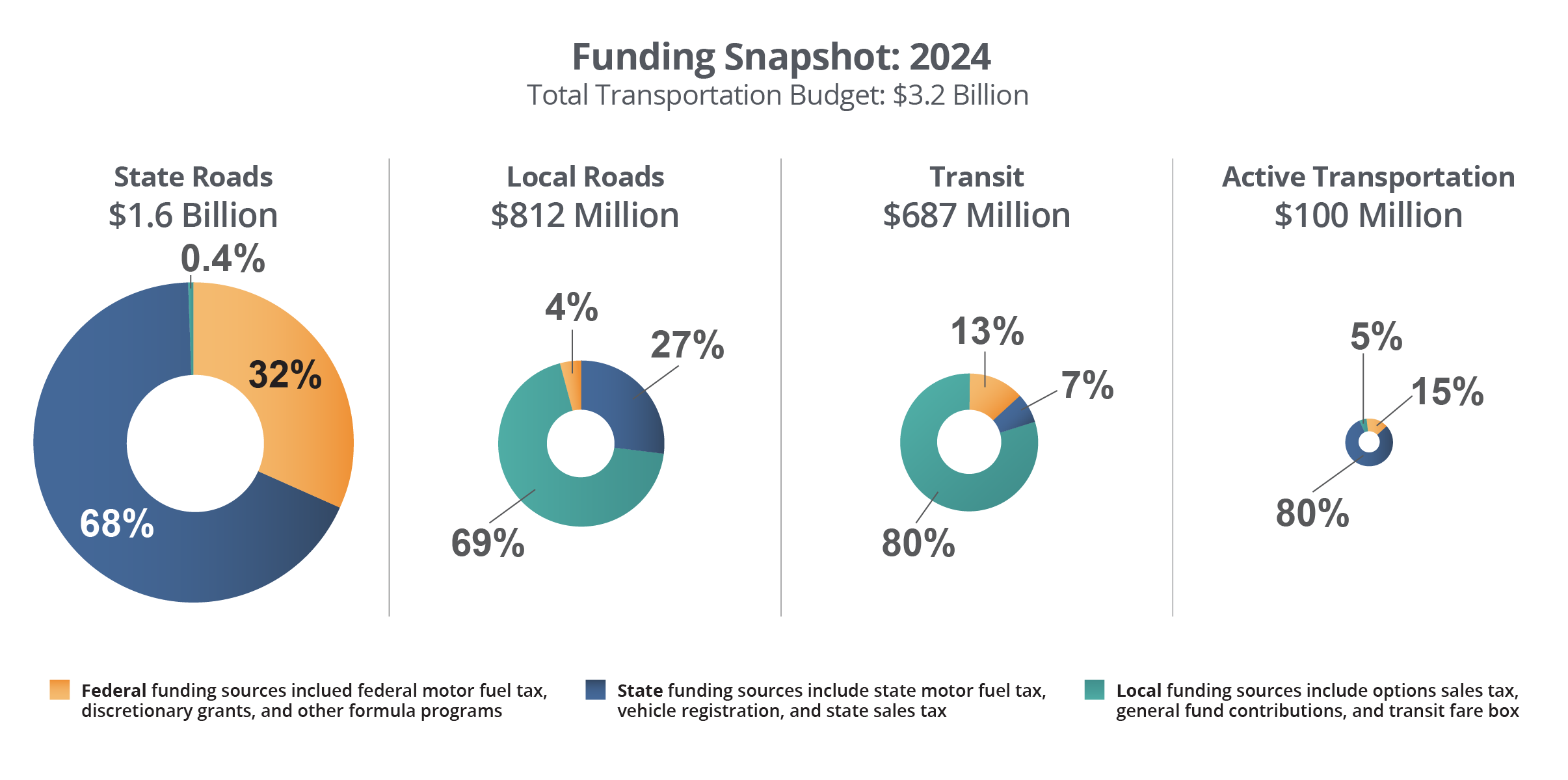
Maintenance Savings
Keeping infrastructure in good condition through consistent maintenance saves investment dollars in the future. Part of the annual funding in Utah’s Unified Transportation Plan goes toward maintenance and ensures the longevity of Utah’s transportation system.
